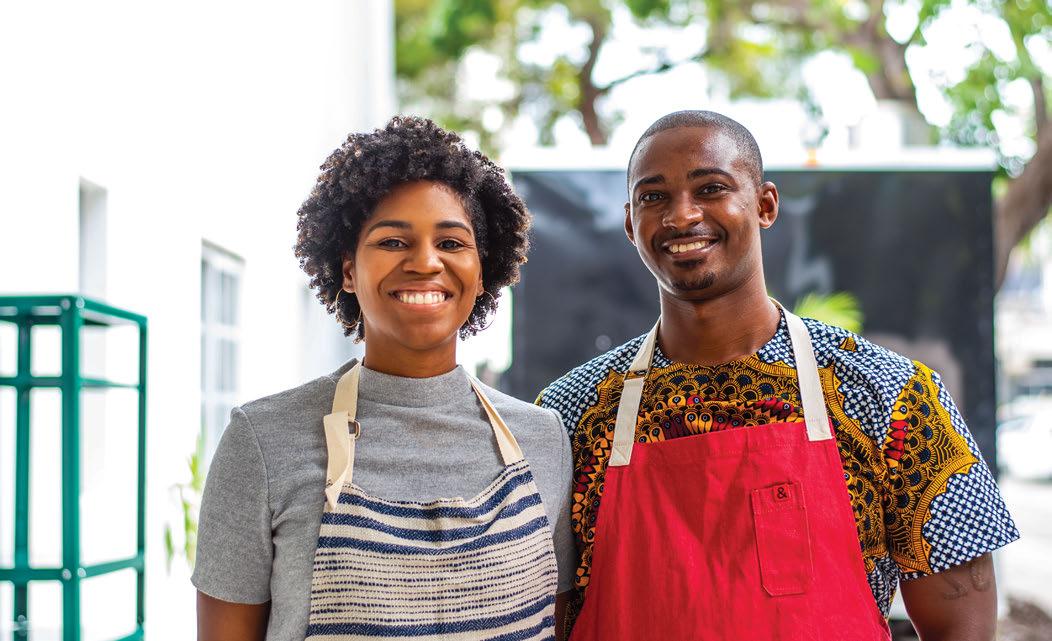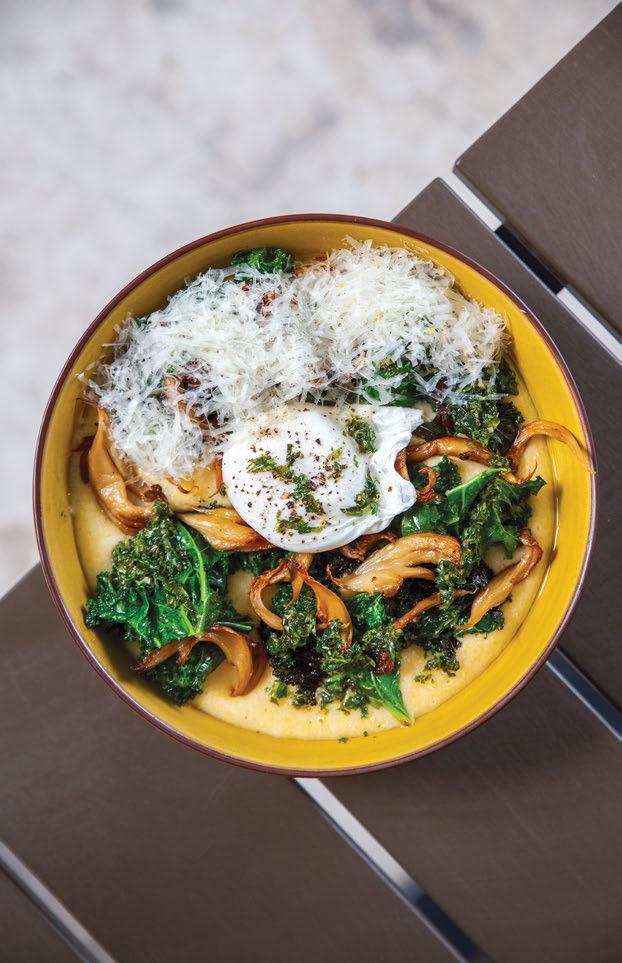
12 minute read
COMMUNITY
2021 MIAMI
COMMUNITY AWARD
Advertisement
PRESENTED BY KIKKOMAN USA
Jamila Ross and Akino West
ROSIE'S MIAMI
Akino West spent most of his childhood cooking alongside his mother, Katrina, in their Riviera Beach home. While attending Palm Beach Gardens High School, Akino took a beginner's culinary class. His teacher, Chef Tammy Johnson Newman, witnessed passion and a competitive drive for cooking and encouraged him to enter culinary competitions. Meanwhile, Jamila Ross grew up in Yonkers, N.Y. and always had a fascination with restaurants. After working at a bagel shop, she scored a line cook job within garde manger at X20, Xavier’s on the Hudson. At 15, she jumped in right after the interview and stayed for three summers. She graduated from both the CIA and Johnson & Wales in Florida, where she met West.
After graduation in 2015, West became sous of Michael’s Genuine Food & Drink, where he met one of his mentors, Michael Schwartz. West took eight months o for a life-changing stage at Noma before returning to Michael’s. He then moved on to 2016 Rising Star Niven Patel’s Ghee.
Ross found an externship at e Bazaar by José Andrés LA and transitioned to frontof-house. Staying with the group, she helped open the SLS South Beach before being promoted to the company’s Kuwaiti arm. Ross moved back to Miami in 2015 for e Langford Hotel and reconnected withWest—they’re getting married in May. ey opened e Copper Door B&B in 2018 with a company mission to promote cultural tourism in underdeveloped areas. COVID-19 led to the addition of Rosie’s Miami. With quality ingredients and service, the restaurant brings guests to the Overtown neighborhood, where Ross and West hire locals, partner with nonpro ts, and host free events for the community. findmewherefoodis / chef_west / rosiesmia
Jamila
Favorite kitchen tool: Microplane Tool you wish you had: Blast chiller Advice to your younger self: Have con dence. Speak up. What you eat on your nights o : I love having pasta on days o , whether ne dining or at a greasy spoon. My favorite pasta spot in Miami is Macchialina.
Akino
Favorite kitchen tool: Plating spoon Tool you wish you had: Pasta extruder Where you eat on your nights o : Itamae Most important kitchen rule: Taste everything; serve food that you'd only be willing to serve to your parents or signi cant other.
WARREN JACLYN PHOTOS:
Wild mushroom southern polenta
Jamila Ross & Akino West of Rosie’s Miami Adapted by StarChefs Yield: 4 portions
INGREDIENTS
Herb Gremolata:
1 bunch parsley, nely chopped ½ bunch mint, chi onade (or any fresh herbs you prefer) 5 cloves garlic, grated nely 2 lemons, juiced and zested nely 1 cup good-quality olive oil 1 tablespoon salt
Southern Polenta:
3 cups grits 1 cup ne polenta ¼ pound unsalted butter 1½ cups whole milk 1 cup cheddar cheese, shredded 1 cup Monterey Jack cheese, shredded 3 tablespoons salt
Crispy Mushrooms:
Canola oil ½ cup oyster mushrooms, torn into thin sections ½ cup shiitake mushrooms, cut into thin pieces Salt

Charred Kale:
½ pound Tuscan kale, destemmed and hand-torn into medium-sized pieces Salt
Poached Eggs:
½ cup white distilled vinegar 4 large eggs
To Assemble and Serve:
Parmigiano Reggiano, freshly grated Cracked black pepper Fresh Origins micro lemon balm
METHOD
For the Herb Gremolata:
In a mixing bowl, combine herbs, garlic, and lemon. Add olive oil and mix to combine. Season with salt. Reserve, periodically mixing to incorporate the oil.
For the Southern Polenta:
In a medium pot, bring 2 quarts water to a boil. In a separate bowl, mix grits and polenta. Slowly add to boiling water while continuously whisking, ensuring that it does not stick or settle to the bottom. Once it’s fully incorporated, reduce heat to low. Add butter until fully incorporated. en add milk, cheese, and salt.
For the Crispy Mushrooms:
Add oil to a medium pan on low heat. Once pan is hot but not smoking, add mushrooms. Keep moving the mushrooms in pan until golden brown and crispy, then season with salt. Remove pan from heat, then, using a perforated spoon, transfer mushrooms to a wire rack to drain any excess oil.
For the Charred Kale:
Heat the same sauté pan used for the mushrooms over high ame. Once the pan is smoking hot, add kale. Sauté until kale begins to char, toss, then season with salt. Remove from heat.
For the Poached Eggs:
Add 2 quarts water to a 3-quart pot. Bring to a simmer and add vinegar. Crack egg into pot and poach until soft and the white is completely cooked. Using a slotted spoon, transfer eggs to a paper-towel-lined sheet tray to remove excess water.
To Assemble and Serve:
In a wide, shallow serving bowl, add 8 ounces Southern Polenta. Top with Charred Kale, followed by the Crispy Mushrooms. Place a Poached Egg in the middle of the bowl. Lightly pour Herb Gremolata around the dish and on top of the Poached Egg. Grate Parmigiano Reggiano in a straight line on one side of the bowl. Finish with cracked black pepper and micro lemon balm on top of the Poached Egg.

CHEF JAMES MCNEAL, OVER/UNDER
By David Rosendorf
Photographs by Briana Balducci Jaclyn Warren and Will Blunt


e Miami restaurant world is used to waves. We’ve seen our Mango Gang wave, our Nueva Latina wave, our farm-to-table wave, and wave after wave of out-of-town, big-name chefs with their tourist-friendly steakhouses and big-box concepts. But this latest wave seems di erent. Call it a rogue wave. A new generation of chefs—some locally born and bred, others who worked at top spots around the country before nding their ways here—are doubling down on Miami.
ere isn’t necessarily a unifying theme or style: Some tap South Florida’s culture and ingredients for inspiration, while others nd di erent ways to connect with the community. And many are looking away from the high rents of South Beach and Brickell, instead nding more opportunityies in less touristy neighborhoods. What they share is a con dence that Miami is ready to embrace their diverse viewpoints, a con dence the city has eagerly rewarded.
Born and Raised
You can taste local avors at many of these new places but not in the ways that outsiders might expect. ere’s no mango salsa at Rising Star Chef Michael Beltran’s Ariete, but you might nd crema de malanga—a tuber that’s a staple in Latin American supermarkets—or a local snapper ceviche with papaya leche de tigre. A Cuban-American Miamian, Beltran is as 305 as they come. After working with two of the city’s culinary godfathers, Norman Van Aken and Michael Schwartz, his goal is “to be as Miami as possible.”
Beltran explains: “We serve a lot of things that in Miami are not common. When people say the food culture here is bad, I disagree. e food culture is young.”
He wants to be the chef who brings Michelin stars to Miami, but if Michelin never comes, that’s OK, too: “ e community is why we do this. Miami is why we do this. e independent restaurant thing is tough, but it feels so good when it works.” What chefs like Beltran do with food, Restaurateur Matt Kuscher does with decor and vibe. “I want people to know they’re in Miami,” he says. But not the tourists’ version of Miami: “It’s like Times Square. at’s what South Beach is to us.”
His places are all about the details. La Cocina, “Hialeah’s First Cocktail Bar,” is attached to Stephen’s Deli, a Jewish landmark that dates back to the 1950s. References to local lore like the Ñooo Que Barato discount store and the Hialeah Spider-Man might charm or confound the tourists. “I want people from other places to know they’re in Miami and to not understand the references and to know we have our own language,” Kuscher says. But it’s not really for them anyway. Kuscher’s playing the long game: “I don’t want to be the hot spot. I want to be the place you go for Tuesday dinner for 20 years.”
Over/Under, a self-described “subtropical honky-tonk” is another place made by and for locals. South Florida native



CHEF CAREY HYNES, JAGUAR SUN
James McNeal’s menu might sound like simple bar food, but there’s a lot going on underneath the surface, and the local presence is stealthy but pervasive: local mahi mahi smoked in-house for sh dip and sour orange pie (more about that on page 51).
Amanda Fraga, director of beverage and social media for e Genuine Hospitality Group, grew up in Hialeah and Kendall and has seen the restaurant community become more interactive with professionals hosting events at one another’s restaurants, for example. “I love what's happening in Miami right now,” she says. “People have really come together, so distributors are also coming together. It’s not about grabbing sales from each other anymore. ” When Pedro Mederos of the E&P DMPLNGS pop-up left his home of Miami, he learned about how lacking Miami was in terms of sustainability. (It broke his heart when his niece said that apples come from the grocery store.) “I know Miami, and I love Miami,” he says. “It hurt that I had to leave Miami to nd extraordinary food and extraordinary food systems to learn.”
But now, Mederos is back, and he and his ancée, Pastry Chef Katherine Randolph, want to play a role in creating sustainable food systems here. He says, “I don’t want to be one of those people from Miami that left and then never came back.”
Moving to Miami
e “local avor” here in Miami can be an amorphous concept. We’re a city of immigrants—not just from Cuba but from all over the Caribbean, Latin America, and beyond. So it makes sense that many of the recent contributions to Miami’s dining culture are by chefs from other places.
Many of these transplants actually want to stay, make Miami their homes, and set up businesses that will carry them to retirement. We no longer consider Miami a stomping ground for new talent, a place to slap together sh tacos and club sandwiches for a couple of years before moving on at the rst opportunity. Chefs are staying to build something that Miami can be proud of.
Coming from Chicago, Jaguar Sun’s Chef Carey Hynes says that the Miami dining scene is rapidly evolving, and despite the challenge of this, he plans to stay for a long time: “It does feel good to be part of something from the ground oor.”
Chef Pedro Lara immigrated to Miami and found ways to show o the area’s mostly untapped produce. At Palmar, a hot spot that meshes Chinese food with tropical avors and decor, Lara makes a shrimp dumpling feel Floridian with the additions of local scallops, dill, and avocado mousse.








When Pastry Chef John Maieli’s local ice cream business closed, he debated whether to settle in Miami or New York, where he’s from. He picked Miami, landed the executive pastry chef gig at Beaker & Gray, and eventually saw the local dessert scene expand with more cookie and ice cream shops opening.
“Miami's food scene is young and energetic with exciting new concepts opening all the time,” he says. “Growing up in New York felt like such exposure to food culture. en you come to Miami, and there is all of this totally di erent food culture, and it's just amazing."
Keeping Up the Neighborhood
With Miami’s metamorphosis has come a reinvigoration of neighborhoods that don’t usually attract tourists: Little River, Little Haiti, and Overtown, to name a few. e Citadel, for example, essentially serves as a business incubator for Little River food stalls such as Lil’ Laos and Frice Cream, and the hall has attracted more residential customers during COVID-19.
Despite their amazing collective resume (Scarpetta, Carbone, e NoMad, Eleven Madison Park), Rising Star Chefs Luciana Giangrandi and Alex Meyer opened a taco truck inside a garden center and an Italian restaurant between a coin laundry and a walk-in medical center. Away from the beach, happily in a strip mall, and the furthest thing from a tourist trap, Little Haiti’s Boia De can go old-school with a Tuscan pappardelle alla lepre but also do things more tailored to Miami’s climate like kampachi aglio e olio.
"We want to be part of the community," Meyer says. "We want to support other people who want to have restaurants.” And they have high hopes for that community. Giangrandi says: “In Miami, there’s a lot of room for growth. In Miami, you can have a bigger impact.”
Rising Star Chef Jon Nguyen has worked both sides of the bay; he came down from New York to consult for Mondrian South Beach and stuck around to start Tran An in a Design District food hall. It’s now become a brick-and-mortar restaurant in Little Haiti.
He’s integrated his restaurant into the local community, a neighborhood of predominantly Haitian immigrants that’s now experiencing rapid gentri cation. “I didn’t want the community to feel like they weren’t accepted here and that we were running them out,” Nguyen says. “I want to take care of them for letting us in.”
Tran An started giving out free food to passersby every Sunday during COVID-19 as a thank you. Nguyen says he never would have been able to a ord to open Tran An in New York and appreciates the opportunity.
“I hope people come to Miami and respect the talent that’s here. I don’t think culinary talent is the rst thing that comes to mind here, but there is so much freedom to express yourself,” he says. “Miami has given talented people a platform to do what they love to do.”

CHEFS ALEX MEYER & LUCIANA GIANGRANDI, BOIA DE













